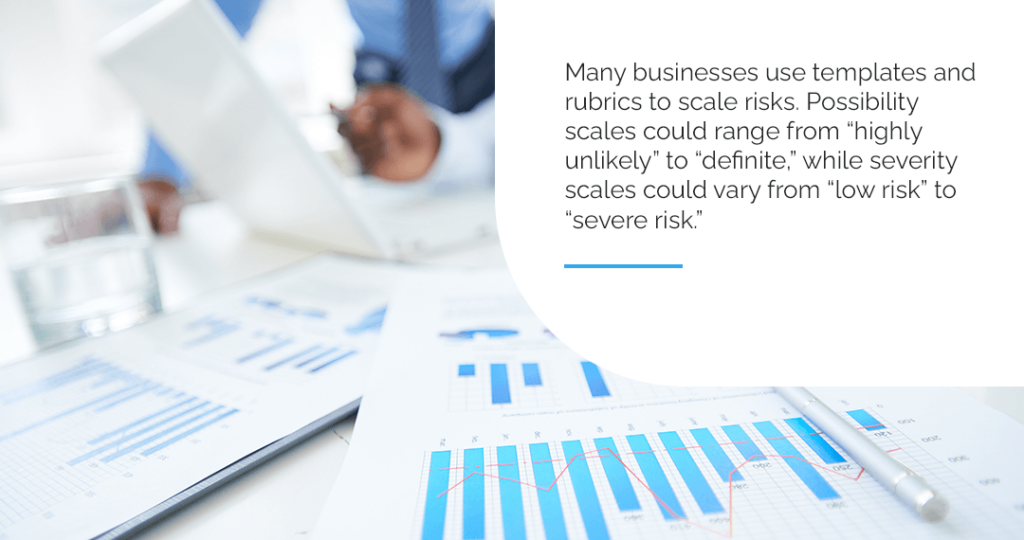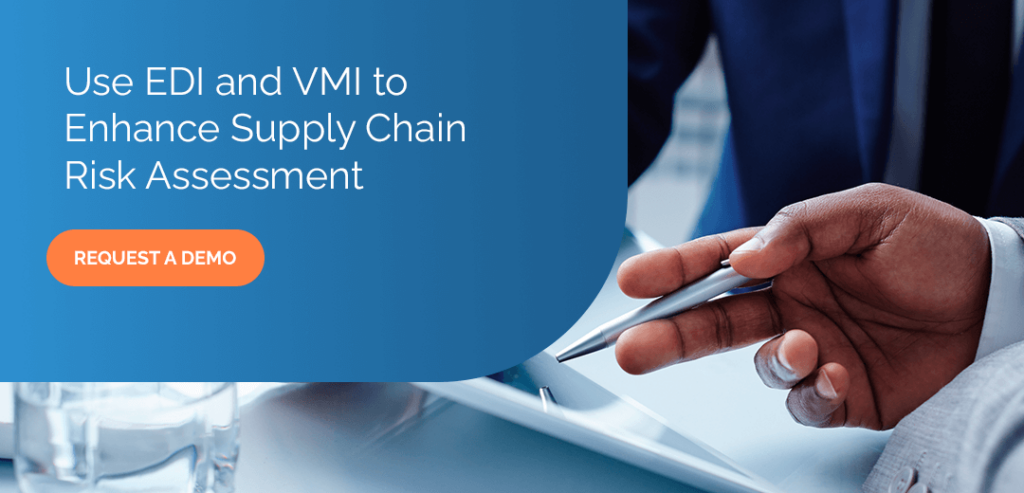How to Conduct a Supply Chain Risk Assessment at Scale

October 4, 2023
Supply chain risk management helps your business minimize negative risk outcomes. Anything from severe flooding to a malicious cyberattack can threaten your business’s daily operations. By implementing robust protection strategies, you can remain resilient against these challenges.
Supply chain risk assessments evaluate potential risks and their impact on all business operations, helping businesses craft the most effective response strategies.
What Is Supply Chain Risk Assessment?
Risk assessments are a crucial component of supply chain risk management. They identify hazards that could negatively impact a supply chain business’s operations. During the assessment process, businesses look thoroughly at possible risks and develop response plans.
Risk management strategies help businesses build resilience for disruptions and other negative supply chain occurrences. Risks can occur internally or externally — they could be entirely within or outside your control. Depending on the risk’s severity, you could experience missed deadlines or lost profits. By proactively anticipating these threats, you can prepare more effectively for them.
Assessments analyze risks from every perspective. You consider how the threats could affect internal operations, supplier relationships, brand image, and other aspects. This approach gives you an end-to-end view of all operations. You can use this enhanced visibility to make more informed decisions when adjusting processes.
Risk Assessment Steps
Companies’ risk assessment approaches vary by preferences, resources, number of supplier relationships, and other individual circumstances. However, most risk assessments contain these basic steps:
1. Determine Possible Risks
The first step is identifying potential risks. Threats can originate within your company or from external sources, creating many considerations. Your business can analyze your position, workflows, commonly used resources, location, and other factors that could create risks. You can gather information from past experiences or by studying current global threats.
Many risk types could affect your business, including:
- Cybersecurity risks: If your business uses software to monitor inventory, process orders, or any other sales component, cybersecurity threats could cause serious damage to your systems. Malicious attackers continue to evolve their approaches, moving beyond security defenses and stealing sensitive data. Data breaches cost an average of over $4 million worldwide, making them significantly harmful to your company’s financial health.
- Supplier risks: Supply chain companies rely on strong and effective supplier relationships. Suppliers must send products and raw materials according to a defined schedule, or production times will suffer. If your suppliers face internal setbacks, their delays also impact your regular operations.
- Environmental risks: Severe weather events can prevent shipments from leaving distribution centers or lengthen transportation times. If your company is located in an area known for poor weather conditions, the risks can be even higher. For instance, companies residing in a hurricane-prone region or an area with excessive snow can experience more significant threats to regular operations.
- Internal risks: A wide range of internal occurrences can disturb workflows. For instance, employee mistakes or absences might limit efficiency and make it harder to meet deadlines.
2. Identify Affected Parties
After you determine potential risks, you can analyze them more closely. The next step of risk analysis identifies how the threats would impact every area of your business. For example, consider their effect on:
- Stakeholders: Shareholders are directly impacted by the company’s success. If an event causes lost profits or brand damage, stakeholders will also experience negative impacts.
- Suppliers and distributors: Most supply chain operations are interconnected. If disruptions impede your manufacturing or distribution processes, other supply chain companies will feel the effects. Depending on the severity, the risks could damage your relationships with other professionals and make it harder to rebuild them.
- Company assets: Risks can also impact financial and physical assets. Adverse weather could harm your business facilities, making it difficult to carry out regular operations. Cyberattacks can also jeopardize your business networks and systems. In addition, significant setbacks can decrease profits.
- Business image: A positive brand image is essential for business success. Negative experiences can damage your public image and decrease customer satisfaction. For example, failing to fulfill orders can frustrate customers, or issues with compliance or employee safety can create a negative image for the public. It’s often difficult to recover from severe reputational damage.
3. Evaluate Risks
Next, you evaluate your business’s risks by severity, probability, and other specific factors. This step lets you prioritize risks according to how severely they would affect your business.
For example, a data breach will likely have more lasting impacts than a supplier delay. Data breaches threaten business and customer data, resulting in significant financial and reputational setbacks. Supplier delays might lengthen lead times and cause you to miss deadlines, but they’re usually more manageable.

Many businesses use templates and rubrics to scale risks. Possibility scales could range from “highly unlikely” to “definite,” while severity scales could vary from “low risk” to “severe risk.” For example, cyberattacks are very likely to happen and pose a severe risk, while supplier setbacks are likely to happen but have a lower risk of severe consequences.
4. Develop Risk Mitigation Strategies
The final stage of risk assessment is to develop risk response plans. You can prioritize risks by their expected severity and probability, which was calculated in the previous step. These plans predict outcomes and allocate necessary recourses to minimize negative effects.
Businesses develop mitigation strategies based on their resources and individual approaches. These strategies protect your company from severe impacts if the risks occur.
For example, if environmental challenges are a significant worry for your business, you could increase product stock during adverse weather seasons. By increasing inventory amounts, you could avoid stock-outs if it becomes difficult to receive products due to ongoing weather. You could also increase your number of supplier relationships in case one becomes unavailable.
In addition, software solutions can help your organization anticipate and respond to risks more efficiently. Tools like Electronic Data Interchange (EDI) and vendor managed inventory (VMI) improve visibility across all supply chain areas, allowing you to predict risks more effectively.
Use EDI and VMI to Enhance Supply Chain Risk Assessment

Risk assessments help you anticipate potential disruptions, keeping your business healthy and resilient. By increasing your awareness of potential threats like cyberattacks, supplier delays, and environmental disasters, you can better prepare your organization for swift responses. EDI and VMI solutions can streamline and enhance many aspects of supply chain risk management.
Electronic Data Interchange replaces manual communication processes, allowing instant data exchanges between supply chain partners. The software improves accuracy and collaboration, reducing the risks of incorrect orders or miscommunications.
Vendor managed inventory enhances visibility across all supply chain stages. The software solutions forecast buying trends by analyzing supplier and customer data. It monitors all product data, giving you an instant, end-to-end view of all activity. You can reduce risk with improved visibility.
TrueCommerce offers VMI and EDI solutions for businesses at all points in the supply chain. We can help you find the best supply chain solution for your unique needs and risks. If you want to learn more about our solutions, contact TrueCommerce today.
Share this post:
Categories
Stay ahead of the competition
Get expert supply chain insights delivered directly to your inbox weekly.